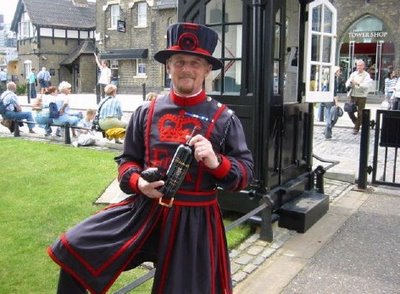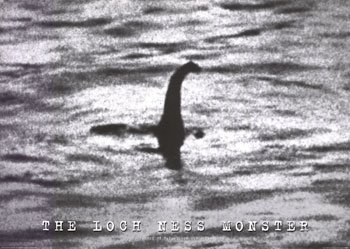
I hear that the Tower of London has employed its first female Beefeater in 522 years. Good thing too. It’s about time these historical attractions were dragged into the twenty-first century. I once visited the Tower with our all-female acrobat team – we got a guided tour from a grizzled member of the yeomanry wearing the famous Toyland costume. Although the fellow did a competent job, he couldn’t resist showing off in front of the girls. I’ve noticed this tendency in the human male – when a gorilla’s in the vicinity, he makes a special effort to convince any watching females that he’s the dude who’s calling the shots.
“As you can see there are trees planted all around the courtyard,” he said, “but I hope our hairy friend won’t be tempted on this occasion.”
I assumed he meant the temptation to climb them rather than piss on them.
“If I do get the urge I’ll fight it with all my strength,” I assured him. “But if worst comes to worst, you can always lure me down by sticking a plum on the end of one of those long spikes you warders are equipped with.”
He grinned sheepishly.
The main history lesson I took from the visit was what appalling despots the monarchs of England used to be. One of the worst was that disgusting ox King Henry VIII, who had the hapless Anne Boleyn beheaded in the Tower courtyard for the alleged crimes of adultery (i.e. playing a game of kiss-chase with a childhood friend) and witchcraft (i.e. singing French ditties while wearing a pointed hat). Her real offence, it seems, was miscarrying the male foetus of the Tudor tyrant, for which a more just reward would have been a purse of fifty guineas.
The Tower complex was certainly impressive, but I left with the feeling that it lacked the romance of a truly first-class tourist venue. Perhaps it’s because it was built by those dour dismal Normans, merciless control-freaks who recorded every cowpat and codpiece in their infamous Domesday Book. That kind of obsessive documentation leaves no room for fable and fantasy, which are the lifeblood of all the most popular historical sites. If I were in charge of the English Tourist Board, I would mug up on Dark Age myths and circulate a few choice stories about places to visit near the Thames.
I hear, for example, that there’s now a giant wheel on the South Bank, where tourists pay a handsome fee for the privilege of gazing at the gorgeous scenery of Tooting. How many more visitors would be lured to that wheel if people realised the historical significance of the plot of land beneath it? It is the very spot, forsooth, where Osgood the Good and his fearless Saxon pikers filleted and skewered the favourite goat of Odkell the Viking, causing the broken-hearted heathen to wander aimlessly though the Thames mudflats bleating maudlin Norse dirges. It is said that you can still hear those laments if you listen hard on Waterloo Bridge on a windswept winter night.
Part of the problem, I suspect, is that the English lack the poetic sensibilities of their cousins north of the border, who have mastered the art of publicising their own myths in the spooky voice of the Highland crofter. The Loch Ness monster is a classic example. I know for a fact that Nessie was actually a circus elephant taking a well-earned bath after performing in a show, but you don’t hear the Scotch pouring cold water on the gibbering of gullible tourists or objecting to the latest Hollywood movie about the legend. Those canny Celtic folk know on which side of the kilt their sporrans are buttered.
“As you can see there are trees planted all around the courtyard,” he said, “but I hope our hairy friend won’t be tempted on this occasion.”
I assumed he meant the temptation to climb them rather than piss on them.
“If I do get the urge I’ll fight it with all my strength,” I assured him. “But if worst comes to worst, you can always lure me down by sticking a plum on the end of one of those long spikes you warders are equipped with.”
He grinned sheepishly.
The main history lesson I took from the visit was what appalling despots the monarchs of England used to be. One of the worst was that disgusting ox King Henry VIII, who had the hapless Anne Boleyn beheaded in the Tower courtyard for the alleged crimes of adultery (i.e. playing a game of kiss-chase with a childhood friend) and witchcraft (i.e. singing French ditties while wearing a pointed hat). Her real offence, it seems, was miscarrying the male foetus of the Tudor tyrant, for which a more just reward would have been a purse of fifty guineas.
The Tower complex was certainly impressive, but I left with the feeling that it lacked the romance of a truly first-class tourist venue. Perhaps it’s because it was built by those dour dismal Normans, merciless control-freaks who recorded every cowpat and codpiece in their infamous Domesday Book. That kind of obsessive documentation leaves no room for fable and fantasy, which are the lifeblood of all the most popular historical sites. If I were in charge of the English Tourist Board, I would mug up on Dark Age myths and circulate a few choice stories about places to visit near the Thames.
I hear, for example, that there’s now a giant wheel on the South Bank, where tourists pay a handsome fee for the privilege of gazing at the gorgeous scenery of Tooting. How many more visitors would be lured to that wheel if people realised the historical significance of the plot of land beneath it? It is the very spot, forsooth, where Osgood the Good and his fearless Saxon pikers filleted and skewered the favourite goat of Odkell the Viking, causing the broken-hearted heathen to wander aimlessly though the Thames mudflats bleating maudlin Norse dirges. It is said that you can still hear those laments if you listen hard on Waterloo Bridge on a windswept winter night.
Part of the problem, I suspect, is that the English lack the poetic sensibilities of their cousins north of the border, who have mastered the art of publicising their own myths in the spooky voice of the Highland crofter. The Loch Ness monster is a classic example. I know for a fact that Nessie was actually a circus elephant taking a well-earned bath after performing in a show, but you don’t hear the Scotch pouring cold water on the gibbering of gullible tourists or objecting to the latest Hollywood movie about the legend. Those canny Celtic folk know on which side of the kilt their sporrans are buttered.

You have read this article with the title The Bloody Tower. You can bookmark this page URL http://celebrityapprenticey.blogspot.com/2007/01/the-bloody-tower.html. Thanks!









